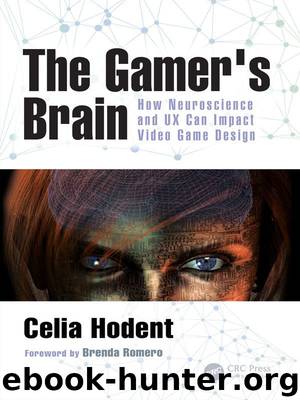The Gamer's Brain: How Neuroscience and UX Can Impact Video Game Design by Celia Hodent

Author:Celia Hodent [Hodent, Celia]
Language: eng
Format: azw3
ISBN: 9781351641241
Publisher: CRC Press
Published: 2017-08-10T04:00:00+00:00
11.2.6 Error Prevention and Error Recovery
Players make mistakes in video games; they die. This is part of many game experiences, and it often wouldn’t feel as satisfying to overcome a challenge if it was too easy (see the game flow pillar in Chapter 13). However, that does not mean you cannot be generous with your players and prevent some mistakes from occurring when that agrees with your intentions. You can also help players recover from errors, especially when errors can cause frustration that does not bring much to the game experience. Keep in mind that, because of cognitive dissonance, if players do not absolutely clearly understand what they are doing wrong, they will likely not blame it on themselves. Like the fox in Aesop’s fable (see Chapter 6), they will instead probably blame it on your game as a way to handle the discomfort of their failure; they will call the game stupid and move on with their lives (unless they are truly motivated to keep feeling the pain of failure to progress in your game).
• Error prevention
We have numerous cognitive limitations; therefore, we cannot pay attention to all that we are doing all the time, and we cannot remember all information we encounter. As a result, players will likely make mistakes. It is your job as a designer to anticipate all errors users can make so you can design to prevent such errors. To take a simple example, if you have two buttons very close to each other but with opposite functions, such as “confirm” and “cancel,” Fitts’s law predicts that the likelihood of a player clicking the wrong button is greater than if both buttons are more spaced out from each other. So move away from the players’ easy reach those buttons that could lead them to wrongly executing a costly action (such as cancelling the download of their game when it was almost complete). Also, add confirmation messages when the action is particularly dramatic or irreversible. For example, in World of Warcraft (Blizzard), it was particularly difficult to accidentally delete a character: You had to type in the word “DELETE” and confirm your intent. Overall, any action that leads to destroying or deleting something should usually require confirmation (or allow for recovery).
Errors are not only frustrating in menus. Within a game world, you can also think of ways to be generous and prevent errors from occurring. For example, in Mario Galaxy (Nintendo), the collision zone of enemies is smaller than their actual three-dimensional model. It allows players to get closer to enemies without being penalized, which is a thoughtful detail given that it is not always easy to estimate how close Mario is from other objects and characters in the game. In games with platforming mechanics, allowing for air control or letting players safely reach a platform even if only one pixel of the character model actually collides with the platform are examples allowing error prevention. In games with crafting mechanics, for example, you can prevent errors
Download
This site does not store any files on its server. We only index and link to content provided by other sites. Please contact the content providers to delete copyright contents if any and email us, we'll remove relevant links or contents immediately.
Deep Learning with Python by François Chollet(15032)
The Mikado Method by Ola Ellnestam Daniel Brolund(12292)
Hello! Python by Anthony Briggs(12183)
OCA Java SE 8 Programmer I Certification Guide by Mala Gupta(11550)
Dependency Injection in .NET by Mark Seemann(11336)
Algorithms of the Intelligent Web by Haralambos Marmanis;Dmitry Babenko(10150)
The Well-Grounded Java Developer by Benjamin J. Evans Martijn Verburg(9811)
Grails in Action by Glen Smith Peter Ledbrook(9479)
Secrets of the JavaScript Ninja by John Resig Bear Bibeault(9045)
Test-Driven iOS Development with Swift 4 by Dominik Hauser(8437)
Becoming a Dynamics 365 Finance and Supply Chain Solution Architect by Brent Dawson(8002)
Microservices with Go by Alexander Shuiskov(7775)
Kotlin in Action by Dmitry Jemerov(7740)
Practical Design Patterns for Java Developers by Miroslav Wengner(7664)
Test Automation Engineering Handbook by Manikandan Sambamurthy(7615)
Angular Projects - Third Edition by Aristeidis Bampakos(7094)
The Art of Crafting User Stories by The Art of Crafting User Stories(6559)
NetSuite for Consultants - Second Edition by Peter Ries(6488)
Demystifying Cryptography with OpenSSL 3.0 by Alexei Khlebnikov(6264)
